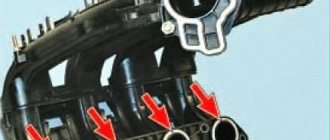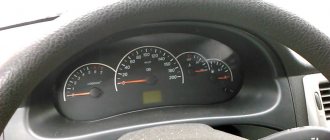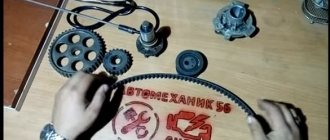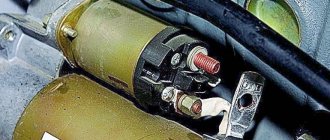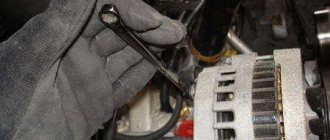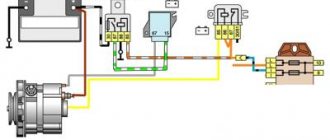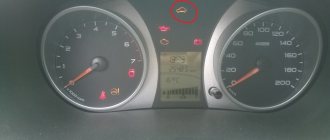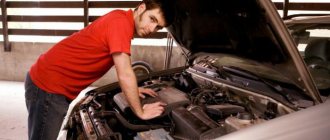Problems with a car arise at any time if you do not carry out regular diagnostics and do not prevent the failure of one or another part in a timely manner. Often, car owners are faced with a situation where the starter clicks, but for some reason does not turn on a Priora. The driver hears a characteristic click, but nothing happens (the car does not start). Due to ignorance of the causes and possibilities for eliminating such a problem, many decide to start the car with a pusher or look for other methods. However, as practice shows, other methods turn out to be labor-intensive, complex, time-consuming and not always effective. In order not to waste your own energy and time, you should find out why such a problem occurs and what to do to fix it.
The starter is the main starting unit of the car. Its function is to spin the motor shaft to the starting speed.
If the Lada Priora's starter does not turn
Possible malfunction
Burnt starter commutator, stuck brushes or severe wear
Open or short circuit in the starter armature winding
| Diagnostics | Remedies | |
| Low battery | The voltage at the battery terminals without load is less than 12V. When trying to start the engine, a cracking noise is heard from under the hood. | Charge the battery or replace it with a new one |
| Oxidation of battery terminals or wire terminals, their fit is not tight | When you try to start the car, the voltage in the on-board network drops much more than at the battery terminals. In this case, a crash may be heard under the hood. | Clean the contacts, lubricate them with petroleum jelly and tighten the terminals |
| The engine or attachments are jammed | Check the rotation of the crankshaft, pump and generator pulley. | Repair engine, generator, pump |
| The starter is faulty, the starter drive gear or flywheel ring teeth are damaged | Remove and inspect the starter. | Repair or replace starter |
| The starter switching circuit or starter relay is faulty, the wires are damaged, or the ignition switch contacts do not close | When the key is turned to position “II”, the starter traction relay does not operate (a click is not heard under the hood). Check the +12V supply to the control contact of the traction relay. | Replace starter relay, wires, ignition switch |
| The starter traction relay is faulty, there is a short circuit or break in the retractor winding, the relay armature is stuck | When the key is turned to position “II”, the traction relay does not operate (there is no click under the hood), but + 12V is supplied to the control contact of the traction relay. Remove the relay and check its operation. | Replace the traction relay |
| Contacts or wires of the traction relay are oxidized, poor ground contact | When the starter is turned on, a clicking sound is heard under the hood, but the starter armature does not rotate. Using an ohmmeter, check the resistance of the Battery-Starter circuit, as well as the ground wire. If the circuit is in good condition, remove the starter and check the operation of the traction relay by applying +12V to it from the battery | Tighten the terminals, clean the contacts, replace the traction relay |
| Open or short circuit in the holding winding of the traction relay | When you try to start the engine, you hear a crashing sound under the hood. The battery voltage is within normal limits. We check the traction relay with an ohmmeter or by its excessive heating. | Replace the traction relay |
| The starter armature rotates slowly or does not rotate at all. Check the traction relay by applying voltage to the starter contact bolt directly from the battery | Replace starter or armature | |
| Freewheel slipping | When the starter is turned on, the armature rotates, the flywheel is stationary | Replace clutch or starter |
Priora won't start, starter turns
Possible malfunction
| Diagnostics | Remedies | |
| There is no gasoline in the tank | On the instrument panel the fuel level indicator is at zero. | Pour gasoline |
| Battery is low | The voltage at the battery terminals without load is less than 12V. When trying to start the car, a crashing sound is heard from under the hood. | Charge the battery or replace it with a new one |
| Oxidation of battery terminals or wire terminals, their fit is not tight | When you try to start the engine, the voltage in the on-board network drops much more than at the battery terminals. In this case, a crash may be heard under the hood. | Clean the contacts, lubricate them with petroleum jelly and tighten the terminals |
| Unreliable connection of electrical circuits of engine control and power supply systems | Check the connections of the connectors and the reliability of the contacts in the blocks. | Fix faulty wire connections |
| Increased resistance to rotation of the crankshaft (scores on the shafts, bearing shells, cylinder-piston parts, deformation of the shafts, frozen engine oil, jammed generator, jammed coolant pump) | The crankshaft turns slowly. If the engine is started in severe frost, and the engine was working properly the day before, then most likely the engine oil has frozen. If you hear extraneous noise when starting the engine, check the free rotation of the pump and generator pulleys. | Use the recommended engine oil. Repair the engine. Replace the pump and generator. |
| Malfunction in the ignition system | Check for spark. | Check the circuits and devices of the ignition system. Replace faulty system elements. |
| The high voltage wires are connected in the wrong order or the wire is disconnected | Inspect. | Connect the wires in the correct order |
| The timing belt is broken or the belt teeth are cut off | Open the front timing cover and check. | Replace timing belt |
| Disturbed valve timing | Check the marks on the crankshaft and camshaft pulleys. | Set the correct shaft position |
| Malfunction of the computer (brains), its circuits, crankshaft position sensor or coolant temperature | Check the supply of +12V to the ECU, the sensor circuit, and the absence of damage to the sensors themselves. | Replace ECU, sensors. |
| The idle air regulator (IAC) or its circuits are faulty | Check the idle air control. When starting the engine, lightly press the gas pedal. If the engine starts and stalls when you release the gas pedal, the sensor is faulty. | Replace sensor |
| The fuse is blown or the main relay of the control system is faulty | Check fuse and relay. | Eliminate the cause of the blown fuse. Replace fuse and relay |
| Fuse blown, fuel pump relay. Circuit, relay or pump is faulty. | When the ignition is turned on, there is no sound of the pump running. Check the fuse. Apply voltage to the pump from the battery. | Clean contacts, replace faulty circuits, replace fuse, pump and relay. |
| The fuel filter is dirty, the water in the fuel line is frozen, the fuel line is damaged | Check the pressure in the fuel rail and the condition of the fuel lines. | Replace the filter, blow out or replace the fuel lines. |
| Insufficient pressure in the fuel rail | Check the pressure in the fuel rail, the pump strainer and the condition of the fuel lines. | Clean the filter. Replace pump, fuel pressure regulator |
| Faulty injectors or their power supply circuits | Check the injector windings with an ohmmeter. Check the chains for breaks. | Replace injectors, replace chains |
| Air leak into the intake tract | Inspect the joints and fittings of the hoses and clamps. During start-up, turn off the vacuum brake booster and plug the receiver fitting. | Eliminate air leaks, replace vacuum booster |
If the Priora does not start well when hot
In this case, see the second table; in addition to the reasons described, also pay attention to:
- A pressure regulator that can discharge fuel through a membrane into the receiver.
- DPKV contacts, if the sensor has been changed, check that the poles are connected correctly.
- Faulty ignition module.
Let us remind you that in some cases the Priora does not start due to a faulty immobilizer or alarm system. In some cases, reflashing the engine ECU (electronic control unit) helps solve the problem of poor starting. And regular car maintenance will help eliminate problems of poor engine starting.
Problems with a car arise at any time if you do not carry out regular diagnostics and do not prevent the failure of one or another part in a timely manner. Often, car owners are faced with a situation where the starter clicks, but for some reason does not turn on a Priora. The driver hears a characteristic click, but nothing happens (the car does not start). Due to ignorance of the causes and possibilities for eliminating such a problem, many decide to start the car with a pusher or look for other methods. However, as practice shows, other methods turn out to be labor-intensive, complex, time-consuming and not always effective. In order not to waste your own energy and time, you should find out why such a problem occurs and what to do to fix it.
The starter is the main starting unit of the car. Its function is to spin the motor shaft to the starting speed.
Starter crackling sound when starting = expensive repairs? There is a cheap way!
When there is a metallic crackling sound upon startup, you cannot delay it. If you delay repairs, you may end up having to replace the flywheel. The cracking noise occurs due to ground teeth on the flywheel ring and teeth on the starter gear.
At the first symptoms of a metallic crackling sound when starting the engine, you can get by by replacing the starter guide bushing. A starter bushing costs no more than a hundred rubles, the main thing is to pay attention to the breakdown in time.
Removing the starter and replacing the bushing will cost much less than removing and replacing the flywheel. The flywheel is removed after removing the gearbox. Based on this, replacing the flywheel rim will be expensive and time consuming.
The rim is replaced when the rim is heated. If the rim is not installed correctly, there may be displacement, or the rim may burst.
The cause of the crackling noise may also be due to a faulty starter bendix. In any case, repairs must begin by removing the starter. The main thing is not to delay repairs!
Causes and solutions
If the car does not start because the starter does not turn, but makes characteristic clicks, there may be several reasons for this:
- The power wire connecting the relay winding and the starter has burned out.
- The brushes and bushings are out of order.
- The armature is shorted on the winding.
- The winding has broken.
- The fork on the drive is deformed or destroyed.
The cause may also be insufficient battery charge. In some cases, to eliminate this problem, it is enough to charge the battery and try to start the car again. The cause may be jamming of the motor shaft and bushing. It is possible that the rotor caught the “plus” of the stator. It is also possible that the winding is shorting.
Even if the problem is easily and quickly solved, one glance will not be enough to detect it. To understand the reason, you first need to let the car cool down (this requirement is especially important in hot weather).
You will have to remove the clicking starter.
If the problem is with the shaft, it needs to be tightened. It may have malfunctioned. Then the shaft will need to be replaced, after which the starter will continue to function normally. If the bushings are deformed, they will need to be replaced. This happens extremely rarely, so in most cases you will not have to replace the bushing to fix the problem. If the rotor rubs against the stator, the shaft must be aligned. You can determine whether a wire has burned out by the appearance of black spots and a characteristic odor.
Diagnostics
The first step is to determine the source of the sound. You can do this yourself, but in this case you need to clearly know the characteristic sounds of each mechanism. The easiest way is to ask a friend to start the car, and listen and determine the source yourself.
In 99% of cases, the malfunction lies in such elements of the engine compartment as:
3) Power steering.,
Bearings creaking
Typically, various bearings run for 100 thousand kilometers or more. However, over time, the lubricant inside them runs out and the elements begin to rub, making a creaking noise. These bearings don't last long. In winter, this worsens due to the loss of lubricating properties of the filler.
Whistling belts
Whistling belts are the most common cause of all of the above. This occurs due to their wear and tear, as well as temperature changes. Some spare parts manufacturers make drive belts from low-quality rubber, which quickly hardens in the cold.
Power steering
If it whistles for 3-4 seconds and then stops, this is normal. In the cold, the technical fluid also loses its fluidity, so for some time the pump operates with overload. However, if the power steering does break down, you should not do it yourself, as it is a very complex mechanism.
Problems with the relay or battery
If, when you try to start a Priora car or a car of another brand, you hear a click, but the starter turns very slowly, you need to clean the nickels. In some situations it may be necessary to solder a new contact layer. If you suspect that the cause is in the motor, you need to close the contacts in the relay. If after this the engine was able to start the first time, look for the cause of the malfunction in the relay. Otherwise, the cause lies in the engine itself.
Often this problem occurs due to a fault in the relay. This is evidenced by the occurrence of several clicks that occur one after another when trying to start the car. If you listen, it becomes clear that this sound is made by a relay. It occurs due to the fact that the starter receives an electrical charge, but the current only reaches the traction relay and does not reach the engine spin-up mechanism. In this case, you can immediately rule out the version of a discharged battery, since due to the low charge, the starter would still be able to turn, but slowly and only a few times.
How to solve the problem and start the engine?
How to start a car if the starter is faulty?
There are several options to solve the problem:
- The most common is to start the engine using a pushrod. The car must be pushed until it can reach a certain speed required to take off, preferably in third or second gear. Only a car with an automatic transmission cannot be started from a pusher.
- Try closing the starter. To do this you will need a screwdriver as well as a wrench. The size of the key must be selected in accordance with the distance between the relay terminals - they will need to be closed. The gearbox selector is set to neutral, the brake pedal is pressed, and the key must be in the required position.
- As a rule, the starter simply has to be repaired, but as practice shows, this mechanism can rarely be repaired. It would be advisable to make repairs if the bendix or relay fails. If the malfunction affects the electrical system, the device will need to be replaced.
Starter malfunction
If, when starting the engine, the starter makes one loud click and nothing else happens, in 100% of cases this is caused by problems in the module itself. One click indicates that charge is reaching the starter as the relay clicks. In this case, failure of the relay is excluded. The cause of the problem with the functioning of this module may be an unstable charge that reaches it. In this case, you should try to start the engine again, and repeat attempts at intervals of 20 seconds. Perhaps on the 2nd or 3rd try you will be able to start the car. If the engine still does not start, investigate the following potential causes of the problem:
- the starter bendix has failed;
- the retractor is broken;
- the main winding of the starter is broken;
- winding short circuit;
- brushes and bushings are worn out.
In the latter case, it is only necessary to replace the failed components.
In any case, regardless of the reason why this problem occurred, the first step is to inspect and check all contacts visible from the outside. Often the starter stops performing its functions normally due to weak contact in one or another node. An unstable charge is also a fairly common cause. In this case, you just need to repeat the attempt to start the engine several times. Most likely, after two or three attempts you will be able to start the engine, and a similar situation will not repeat during subsequent starts.
Even if you eventually managed to start the engine after some attempt, you should not consider the problem solved. Otherwise, at some point the car will simply stop starting and you will have to look for alternative ways to start the engine. You should not solve the problem by replacing the starter.
As can be seen from the article, in most cases the cause of the breakdown is not the failure of the starter. Therefore, replacing it will not help fix the problem. If you doubt the suitability of the starter, it is necessary to carry out high-quality maintenance and check all components of this module. It is better to entrust this work to specialists. You just need to dismantle the starter and take it to a service station for diagnostics and troubleshooting.
Author: Alex December 20, 2016 Category: Car fault diagnosis
In the modern world, a car is no longer an element of luxury; it is rather an integral part of the lives of most people. However, operating a car, like any other mechanism, is very often associated with not the most pleasant moments, especially when the car stops working as it should.
Among car problems, the most common problem is starting the engine. There can be many reasons for this phenomenon, and for a more accurate diagnosis of the problem, you should find out which mechanism or unit is failing.
The starter itself is often to blame for problems with engine starting. Its job is to spin the engine crankshaft to the frequency necessary to start it directly. However, many car enthusiasts are faced with the following problems: the traction relay clicks, but the starter does not turn - the car does not start. What are the reasons for this behavior of the car and how to start it in this case? In this article we will analyze the most frequently occurring problems that are characterized by similar “symptoms”.
Troubleshooting wires
Some drivers, in search of a malfunction, are in a hurry to remove the starter, but such hasty actions should not be taken, since often the problem of the engine not starting is due to wires, poor contacts or their absence. Here are the most typical defects:
- low weight of the engine and body;
- unreliable connection of the starter wires (plus of the rotor winding, main plus, power supply contact from the ignition switch to the solenoid relay (SR)).
If there is a bad ground on the engine, a sign of a defect will be a slight click on the first attempt to start, then all the instruments may go out, and with the next turns of the key any signs of “life” will disappear altogether (but not necessarily). Checking the presence of mass is quite simple, but the check needs to be done by two people:
- one of the participants closes the mass terminal of the battery with the engine housing with a metal object (for example, a wrench or a cigarette wire);
- the second person, sitting behind the wheel of the car, turns the key all the way to the right;
- If there really was a bad ground, the starter will immediately start turning at normal speed.
You should also ensure the reliability of all fasteners on the starter; to do this, perform the following steps:
- unscrew all the nuts on the starter, having previously removed the terminals from the battery;
- wipe the joints and fasteners with a dry, clean rag;
- treat contacts with WD-40;
- tighten the nuts with the necessary force; do not overtighten, otherwise you may break the thread.
If the BP wire is connected using a connector, bend the tongue of the “chip”; here the connection should be tight.
When, after cleaning all contact parts, the engine starts, it means that the malfunction has been eliminated, and there is no need to find out what caused the defect. If nothing has changed for the better, then you should definitely check the starter; to do this, the unit will have to be dismantled.
Battery, wiring, terminals
As a rule, relay clicks indicate that the device is working. When the relay clicks, but the starter does not turn, the car does not start most often due to the fact that the starter does not have enough electric current to spin the crankshaft. If there was no power supplied to the starter at all, we would not hear any clicks.
Most often, this situation arises due to a banal battery discharge (or simply a low charge level). It is not difficult to identify this problem; if, when you turn the ignition key, the solenoid relay clicks and the lights on the instrument panel go out, then the problem is in the battery.
Remember that sometimes you won’t be able to solve the problem by simply charging the battery. First of all, it is worth finding out the reason for the battery discharge, so as not to encounter this problem in the future. It’s good if the cause of the discharge was a light that was not turned off or another source of consumption, but if the problem is, for example, in the generator or the battery itself, then no amount of recharging will help you.
We also recommend reading the material on the topic: how to extend the life of a car battery. After reading this article, you will also learn about the reasons for battery discharge and signs that the battery will soon fail.
The next most common cause of starter inoperability is damage to the ground wire going to the engine or poor contact. If there is not just one click, but a whole series, this is probably the problem.
And if only one click is heard, then the problem should be looked for in the contacts of the starter, or rather its relay. The starter is powered by a current of approximately 200 amperes, but due to poor contact in any place, the current can reach much lower values. It may be enough to trigger the retractor relay, but this current strength will not be enough to ensure the rotation of the crankshaft.
In some cases, the contacts of the starter relay may burn out, as a result, there is no spark necessary to ensure correct operation of the starter. Actually, a click is not a characteristic sign of serviceability of the starter relay, it only indicates that the relay core is retracted, but the holding winding sometimes cannot fix it.
First of all, you should try to start the starter forcibly, and not from the vehicle’s on-board system. The starter solenoid relay has three contacts, two of them are larger and the third is slightly smaller. It is necessary to close the two large contacts using a screwdriver. If in this case the starter starts to rotate, the solenoid relay is to blame. As a rule, it must either be completely replaced or its contacts cleaned.
Let's watch the video where the author tells what to do if the starter does not turn, and how to close the starter contacts:
We also recommend reading an article about the main reasons why the starter turns but does not engage, and how to fix this problem.
Options for trouble
But it also happens differently: you sit down, turn the key, a dry click, as if a gun breech had clanged. Or, instead of the familiar sound of the starter spinning the flywheel, you hear the howl of an unexpectedly switched on electric drill, and nothing but a buzzing sound. Or when you turn the key, an incomprehensible grinding noise is heard. Otherwise, nothing came to life except the instrument panel.
The neighbors in the parking lot who understand this will competently and sympathetically say: “However, the starter died.” Or maybe even in more detail, like: “Bendix is covered, the retractor is stuck, the stator is burned, the armature is jammed...” In general, there is little good.
And it’s okay when summer is warm and sunny. He closed the door, kicked the tire in frustration, hailed a taxi, and off to work. What if, like now, it’s winter? While you dug the car out from under the snow, while you warmed up the door lock, you can barely get the key into the ignition with your crooked fingers... and then it’s on you! Some, without figuring it out, also try to start several times, draining the battery at the same time.
Of course, you can simply not give a damn about a broken starter, hide everyone who comes to hand as a draft force and start, as they say, from the pusher.
You can get a cable, hook onto the car of a neighbor who did not have time to escape in time, and launch “on a tie”. However, compacted snow or ice may simply not allow the wheels of the towed car to properly catch on the asphalt, and therefore they may drag you for a long time, but to no avail.
There is generally an exotic method that owners of front-wheel drive cars can resort to: put the car on the handbrake (preferably with “shoes” under the wheels), jack up the front wheel, shift the gearshift lever to a high (about fourth) gear, turn on the ignition and spin it by hand hanging wheel. Circus! But they say that this method gave results to someone.
True, the computer systems of many modern cars will allow you to roll the car around the parking lot for as long as you like or spin the wheel ad infinitum without any use - well, they don’t provide for push start!
And owners of cars with an automatic transmission may not even try to do this, unless, of course, they specifically set out to provide auto mechanics from the nearest service station with the necessary amount of work to repair the automatic transmission. And there are such things - I saw them myself.
In general, the best option is a tow truck (or towing in neutral) and a car service.
Although there is another “good” starting option: in many parking lots in severe frosts there will be a well-meaning little man who will offer to solve the problem with the help of a starting charger (“mother-in-law”, “marivanna”, “dope machine”, “helper”, as it is called in vernacular). If only you knew how many starters, charred from the inside, the craftsmen have to deal with in their lifetime thanks to the invaluable help of this unit.
Starter malfunction
Sometimes, when the relay clicks, but the starter does not turn, the car does not start because the starter itself has failed. It is quite possible that the wire that connects the starter winding and its relay has burned out or broken, or that the starter winding has broken.
It is quite possible that a short circuit has occurred in the armature or stator windings, as well as in the brush holder. For example, you can determine a short circuit by looking at the headlights; when you try to start the engine, they dim greatly, and sometimes even go out completely even when the battery is fully charged.
If the car has been used for a long time, the starter brushes may have worn out too much or the starter bushings may have worn out. As a rule, it is impossible to diagnose such problems in the shortest possible time, but if you have enough time, you can find out the cause of the starter failure.
Be sure to watch another video on how the starter works:
If problems arise with starting the engine, you should also not “drive” the starter for too long. The fact is that the starter is essentially a small electric motor, which, however, ensures the rotation of the crankshaft. To do this, it requires a very high current strength, so it is not recommended to operate the starter for a long time within one starting attempt - you run a high risk of damaging it (the contacts may simply burn out). It is recommended to make three short attempts to start the engine, and if they are unsuccessful, proceed to troubleshooting.
